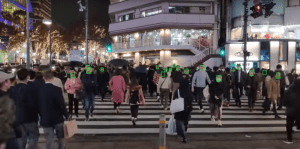D-ID’s Advanced Blurring Solution Conceals Faces and Preserves Privacy

The average Londoner is caught on CCTV security cameras over 300 times a day, while their camera-shy American cohorts only find themselves being recorded by security cameras about 75 times a day. Cameras are everywhere. They monitor crowds, watch traffic, protect retail outlets, and act as security guards on street corners all around the world.
The result is an incredible amount of video footage containing personally identifiable information (PII), which is constantly being created, analyzed, and stored. Individuals being recorded are not asked for their consent, which would be largely impractical under most camera surveillance conditions.
Running Afoul of Regulatory Compliance
GDPR, which protects the individual’s personal data, is wide ranging and includes images and video. If footage captured through a CCTV camera contains enough data to identify someone, GDPR requirements for personal data processing need to be put in place.
Fines for violations can be severe. Between May 2018 and January 2020, the EU handed out over 114 million euros in fines, and experts expect that enforcement and fines will continue to increase. With the power to fine companies the greater of 4% annual revenue or 20 million euros, companies using surveillance cameras need to protect themselves from crippling penalties.
In addition to improper data collection, the European Data Protection Board (EDPB) requires that CCTV operators have the capability to blur faces. Clause 95 says “If a data subject requests a copy of their personal data processed through video surveillance at the entrance of a shopping mall with 30,000 visitors per day, the data subject should specify when they passed the monitored area within approximately a two-hour-timeframe. If the controller still processes the material, a copy of the video footage should be provided. If other data subjects can be identified in the same material then that part of the material should be anonymised (for example by blurring the copy or parts thereof) before giving the copy to the data subject that filed the request.”
Blurring Out PII
D-ID’s advanced blurring solution protects organizations involved in recording and storing footage. The system detects faces on film, and automatically applies blurring to remove PII. It can detect faces even in poor lighting, regardless of facial pose, and can accurately detect masked faces. By blurring out PII, organizations aren’t at risk of violating GDPR principles.
D-ID’s Solutions
D-ID offers two different solutions, and has some exciting offerings on its roadmap.
- SaaS – Blurring is provided as a cloud service. Videos are uploaded to the cloud, where it is processed and securely returned.
- On–Premises – Blurring functionality is integrated into the on-premises video management system, where it can process offline videos and live-streaming camera feeds (May require moderate GPU for real-time processing).
In addition, D-ID has a number of developments currently on its roadmap. These include
- Embedded – Blurring is built into the camera, so that facial PII never leaves the camera.
- Selective Blurring – Certain faces are left intact, while other faces are blurred.

Blurring in Action
This video clip (click image), taken at Tokyo’s busy Shibuya station at night, shows facial blurring under complex circumstances. People are crossing the street, and turning their heads in all directions. Some individuals are wearing facial masks, with some people near and some far from the camera. The blurring level, which can set by the user, is set to low, to demonstrate what the detector is doing under these circumstances.
As you can see, the system is capable of locating a face, and then picking it up again after being blocked momentarily in a frame.
Why D-ID?
D-ID’s advanced blurring offers a number of benefits and protections to organizations who record and store video data. The system protects organizations from regulatory scrutiny, as it complies with GDPR, the Illinois Privacy Law, and other similar laws and requirements, and reduces the need to answer data subject’s requests for information. Because it incorporates privacy by design, it also eliminates the need for consent of individuals being recorded.
Competitive Advantage
D-ID is one of the most advanced video blurring systems on the market today.
Accuracy – The D-ID system boasts state-of-the-art detection rates. It locates and blurs faces regardless of size of crowd or lighting conditions, and can detect faces in infrared, grayscale, RGB and YUV videos. The system is highly configurable, and can adjust its false positive vs. false negative ratio for various use cases.
Smart Face Tracker – The system can detect faces that are momentarily blocked on screen. It can overcome motion blur misdetection, as well as extreme angles and face occlusions, allowing it to reduce the number of frames with non-detected faces.
Performance – The D-ID Advance Blurring solution is capable of providing multi-process and multi-thread support, and can process concurrent video streams (when used with recommended CPU/GPU strength). High-performance GPUs can be shared between streams and parallel file processing. It can process bulk folders, and latency is not impacted by the number of faces in the frame. Full HD movies are processed at 30 FPS. The product can be installed in the cloud or installed and configured on customers’ servers.
Functionality – The D-ID system provides users with the ability to configure the blur intensity level, as well as set the outputs detection confidence level to balance false detect and false misses. It contains a face counter, and is containerized with auto-scaling support under Kubernetes. Selective blurring is part of the roadmap, and will be added to future versions.
Was this post useful?
Thank you for your feedback!